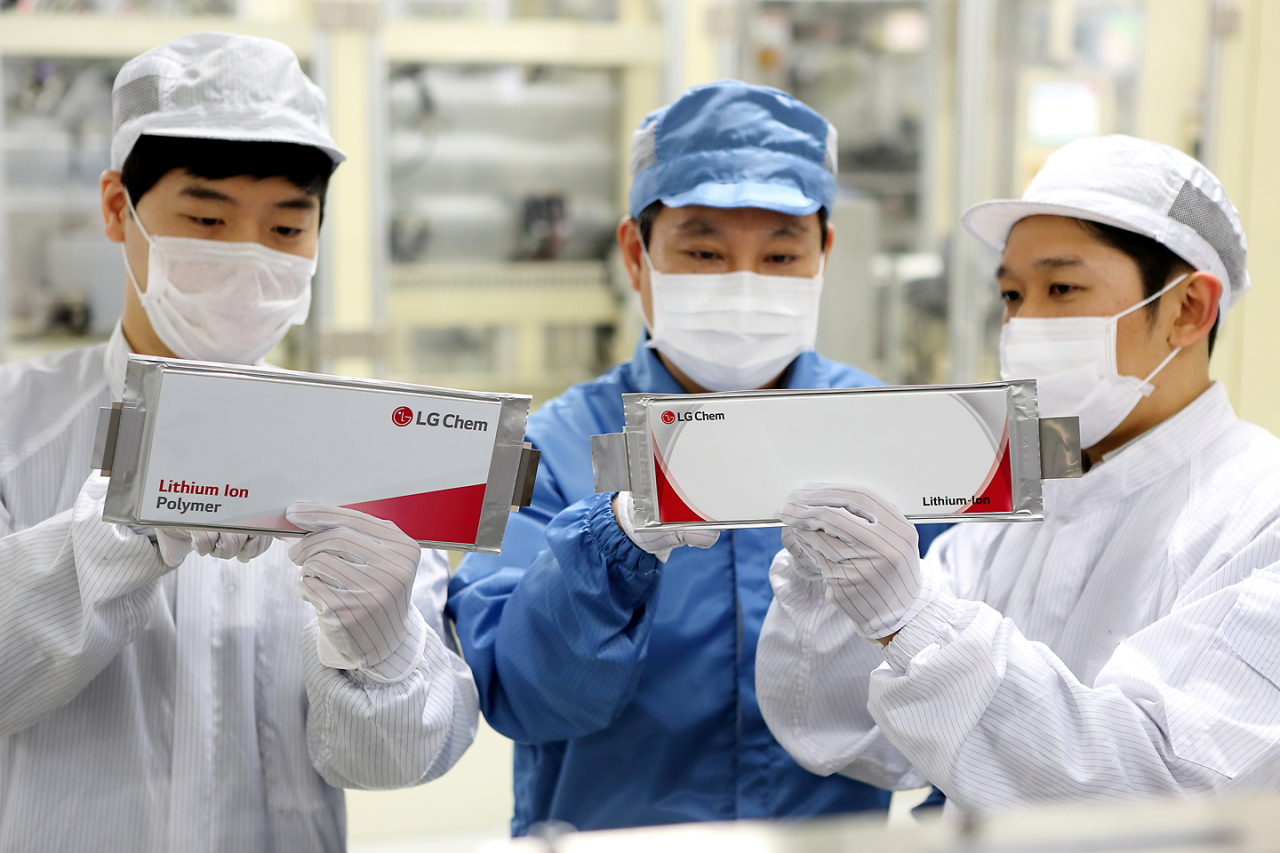[News Focus] LG Chem is ready to defeat CATL
LG Chem’s Q2 results prove it can achieve profitability, quality, scale simultaneously in EV battery biz
By Kim Byung-wookPublished : Aug. 2, 2020 - 16:52

The rivalry between neighboring South Korea and China has existed in multiple industries and in different dimensions.
The long-festering rivalry is also intense between the leading battery makers of each country -- Korea’s LG Chem and China’s CATL -- in the war of electric vehicle batteries.
Despite the many wars it has lost to China, this time, it may be Korea that is winning the battery war.
LG Chem on Friday posted a record quarterly revenue and operating profit of 2.8 trillion won ($2.3 billion) and 155.5 billion won, respectively, in its battery business.
The news came as a surprise not only because LG Chem recorded all-time high earnings in battery business but because it turned profit particularly in EV battery business while local competitors Samsung SDI and SK Innovation failed to do so.
Above all, by turning profit in the EV battery business, LG Chem appears to have proven it could pursue profit and seek rapid expansion simultaneously.
For LG Chem, price competitiveness has always been an issue, as its current global battery production capacity stands at 64 gigawatt-hours compared to CATL’s overwhelming 105 gigawatt-hours.
To narrow this gap, LG Chem aims to reach 100 gigawatt-hours of production capacity by this year and 120 gigawatt-hours in 2021, enough to threaten CATL’s target of 136.6 gigawatt-hours by 2022.
As part of its expansion efforts, LG Chem in April took a loan of 500 million euros ($592.2 million) from three Korean banks -- Korea Development Bank, Export-Import Bank of Korea and Nonghyup Bank -- to expand its production capacity in Europe.
Despite the huge loan, LG Chem’s EV battery business still managed to come up with its best-ever performance in the second quarter, which makes the results all the more meaningful.
If LG Chem and CATL become neck-and-neck in scale within a few years, the fight will no longer be about who can make batteries cheaper but who can make them better, industry watchers say.
“Until now, CATL has expanded its business by playing economies of scale based on the domestic market, but things might be different in the future. As there’s little difference in global supply capacity (between CATL and Korean battery makers), it’s important to enhance technological strengths and expand investments,” an industry source said.
In terms of battery technology, LG Chem is at least two years ahead against CATL, according to the industry sources.
Automakers too know that CATL’s LFP (lithium iron phosphate) batteries -- bulkier and lower in energy density -- are inadequate for third-generation EVs that need to travel more than 500 kilometers.
Carmakers widely use CATL’s LFP batteries mainly due to the Chinese government’s subsidies to EVs loaded with Chinese-made batteries.
Tesla is one of the latest examples succumbing to Chinese government’s pressure, as the automaker pledged to increase the ratio of Chinese-made auto parts to 80 percent from the current 40 percent by the end of this year for Tesla vehicles manufactured in the country.
The Chinese government’s policy helped scale up CATL’s market dominance but is also deemed to have slowed down its global expansion and discourage its technological improvements.
Ironically, the great EV battery wall of China has motivated LG Chem to concentrate less on the Chinese market and take initiative in the premium European market, which is based on NCM (nickel cobalt manganese) batteries. Though more expensive than LFP batteries, NCM batteries can offer greater energy density, which is exactly what LG Chem’s clients in Europe -- Volkswagen, BMW, Daimler, Volvo and Jaguar -- need for longer range for their EVs.
LG Chem now controls 70 percent of European EV battery market and has orders worth 150 trillion won globally, according to KB Securities.
CATL too is currently building a 14 gigawatt-hour EV battery plant in Germany to be completed by 2022, by the time of which LG Chem will have increased its production capacity in Poland from 34 gigawatt-hours to 65 gigawatt-hours.
To strengthen its technology lead, LG Chem plans to introduce high-nickel batteries. The higher the ratio of nickel inside cathode -- one of four key components of lithium-ion batteries including anode, electrolyte and separator -- the greater the energy capacity of batteries becomes, which translates into longer range for EVs.
By 2022, LG Chem plans to mass produce NCMA (nickel cobalt manganese aluminum) batteries that contain 90 percent nickel, 5 percent cobalt, and 1 to 2 percent of manganese and aluminum, respectively, which would be much more powerful than NCM811 batteries of 80 percent nickel LG Chem is currently supplying to Tesla Model 3 sedans manufactured in China.
As for low-end EV market, LG Chem has begun the mass production of NCM712 batteries since this year, slowly moving on from its main product NCM622 batteries and providing automakers an affordable but more powerful alternative to CATL’s LFP batteries.
In January-May period, LG Chem was the leading supplier of EV batteries, deploying 7.8 gigawatt-hours of batteries worldwide, followed by CATL’s 7.3 gigawatt-hours, commanding 24.2 percent and 22.3 percent of global EV battery market, respectively, according to market tracker SNE Research.
“When Tesla announced its second quarter results, it said it would increase the production of Tesla Model 3 sedans in China and ramp up Model 3 and Model Y production to 500,000 units per year at Fremont plant in the US. Also, it finalized its plan to manufacture Model Y and Cybertruck at its second plant in the US. In lockstep with Tesla’s expansion plan, the amount of batteries LG Chem supplies to the automaker will increase,” a Meritz Securities analyst said.
By Kim Byung-wook (kbw@heraldcorp.com)







![[KH Explains] How should Korea adjust its trade defenses against Chinese EVs?](http://res.heraldm.com/phpwas/restmb_idxmake.php?idx=644&simg=/content/image/2024/04/15/20240415050562_0.jpg&u=20240415144419)










![[Today’s K-pop] Stray Kids to return soon: report](http://res.heraldm.com/phpwas/restmb_idxmake.php?idx=642&simg=/content/image/2024/04/16/20240416050713_0.jpg&u=)